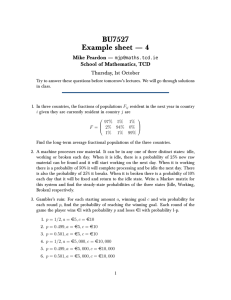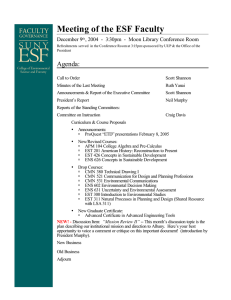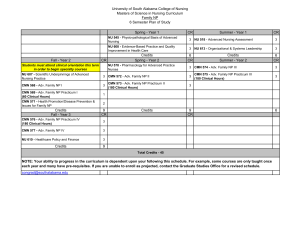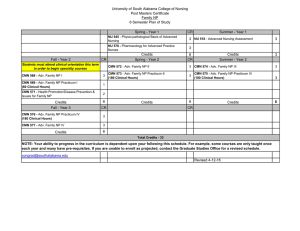PRENILPOTENT PAIRS IN E
advertisement
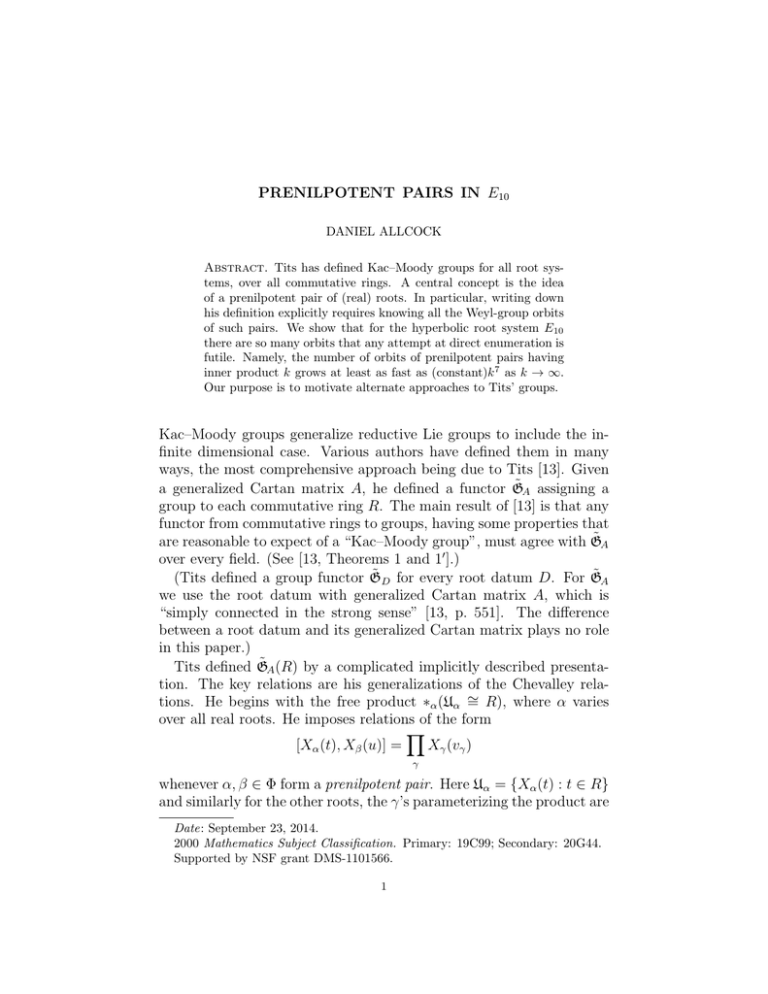
PRENILPOTENT PAIRS IN E10
DANIEL ALLCOCK
Abstract. Tits has defined Kac–Moody groups for all root systems, over all commutative rings. A central concept is the idea
of a prenilpotent pair of (real) roots. In particular, writing down
his definition explicitly requires knowing all the Weyl-group orbits
of such pairs. We show that for the hyperbolic root system E10
there are so many orbits that any attempt at direct enumeration is
futile. Namely, the number of orbits of prenilpotent pairs having
inner product k grows at least as fast as (constant)k 7 as k → ∞.
Our purpose is to motivate alternate approaches to Tits’ groups.
Kac–Moody groups generalize reductive Lie groups to include the infinite dimensional case. Various authors have defined them in many
ways, the most comprehensive approach being due to Tits [13]. Given
a generalized Cartan matrix A, he defined a functor G̃A assigning a
group to each commutative ring R. The main result of [13] is that any
functor from commutative rings to groups, having some properties that
are reasonable to expect of a “Kac–Moody group”, must agree with G̃A
over every field. (See [13, Theorems 1 and 10 ].)
(Tits defined a group functor G̃D for every root datum D. For G̃A
we use the root datum with generalized Cartan matrix A, which is
“simply connected in the strong sense” [13, p. 551]. The difference
between a root datum and its generalized Cartan matrix plays no role
in this paper.)
Tits defined G̃A (R) by a complicated implicitly described presentation. The key relations are his generalizations of the Chevalley relations. He begins with the free product ∗α (Uα ∼
= R), where α varies
over all real roots. He imposes relations of the form
Y
[Xα (t), Xβ (u)] =
Xγ (vγ )
γ
whenever α, β ∈ Φ form a prenilpotent pair. Here Uα = {Xα (t) : t ∈ R}
and similarly for the other roots, the γ’s parameterizing the product are
Date: September 23, 2014.
2000 Mathematics Subject Classification. Primary: 19C99; Secondary: 20G44.
Supported by NSF grant DMS-1101566.
1
2
DANIEL ALLCOCK
the real roots in Nα + Nβ other than α and β, and the parameters vγ
depend on various choices (and anyway are unimportant in this paper).
The definition of prenilpotency is that some element of the Weyl
group W sends both α, β to positive roots, and some other element
sends both to negative roots. When this holds, Prop. 1 of [13] and
its proof show how to work out the Chevalley relation of α, β, at least
in principle. It is akin to working out structure constants of Kac–
Moody algebras. (In fact Hée has worked out all the possible types
of the relations in closed form [7].) So the essence of writing down
Tits’ presentation is to list all the prenilpotent pairs. It would even be
enough to find one representative of each W-orbit of prenilpotent pairs.
Our main result, theorem 1 below, is that this is impossible in practice
for the E10 root system. The argument suggests that the same holds
for all irreducible root systems of rank > 3 (except the spherical and
affine ones; see section 2).
This negative result is balanced by the fact that in many interesting
cases, including E10 , most of the prenilpotent pairs can be ignored because their Chevalley relations follow from those of other prenilpotent
pairs. There are two approaches to this. The first is due to Abramenko
and Mühlherr [1][11][5], and applies to Kac–Moody groups associated
to 2-spherical Dynkin diagrams, over fields, with some exceptions over
F2 and F3 . The second approach is due to the author, partly in joint
work with Carbone [2][3][4]. It works over general rings, but requires
stronger hypotheses on the diagram. Both approaches apply to affine
diagrams (of rank ≥ 3) and all simply laced hyperbolic diagrams, including E10 . In both cases the result is that G̃A (R) is the direct limit
of the family of groups G̃B (R), where B varies over the 1- and 2-node
subdiagrams of A. So one may neglect Tits’ Chevalley-style relations
for prenilpotent pairs that don’t appear in the root systems of the
various B’s. In the author’s approach, one even obtains an explicit
presentation (often finite) given in terms of the Dynkin diagram, for
example G̃E10 (R) and G̃E10 (Z) in theorem 1 and corollary 2 of [4].
Now we begin the E10 -specific material. Although some properties
of E10 simplify the analysis, notably its unimodularity, similar ideas
should apply to other hyperbolic root systems (see section 2). The E10
Dynkin diagram is
Its corresponding generalized Cartan matrix is symmetric, so it may be
regarded as an inner product matrix on the root lattice Λ. The Weyl
group W acts on Λ by isometries. We will never refer to imaginary
PRENILPOTENT PAIRS IN E10
3
roots, so we follow Tits [] in using “root” to mean “real root”, i.e.,
“W-image of a simple root”. Now we can state our main result:
Theorem 1. Let N (k) be the number of W-orbits of prenilpotent pairs
of roots in the E10 root system with inner product k. Then for some
positive constant C we have N (k) ≥ Ck 7 .
The constant is made effective in the proof. The theorem says nothing if k ≤ 0, but this case is uninteresting because there are no prenilpotent pairs with k < −1, by lemma 3 below. Finally, although
polynomial growth is generally considered “tame” in algorithmic settings, the proof shows that the problem of enumerating the prenilpotent
pairs contains an infinite sequence of successively more difficult and
less interesting problems in the classification theory of positive-definite
quadratic forms. Such enumerations, for example “all lattices of dimension 8 and determinant N ”, become uninteresting quite quickly.
Thus our description of the direct enumeration of prenilpotent pairs as
“futile”.
1. Proof
In this section we prove theorem 1 by converting it into a latticetheoretic problem. First we need to describe the roots and prenilpotent
pairs entirely in terms of the root lattice Λ.
Lemma 2. The roots of the E10 root system are exactly the norm 2
vectors of Λ.
Proof. The simple roots have norm 2 because every generalized Cartan
matrix has 2’s along its diagonal. The other roots are their W-images
and therefore have norm 2 also. Now suppose a lattice vector r has
norm 2. The reflection in r, namely R : x 7→ x − (x · r)r, preserves Λ
because x · r ∈ Z for all lattice vectors x. Also, Λ has signature (9, 1),
so the negative-norm vectors in Λ ⊗ R fall into two components. Since
r2 > 0, R preserves each component. Vinberg [14] showed that W is
the full group of lattice isometries that preserve each component, so
R ∈ W . Since every reflection in W is conjugate to a simple reflection,
r is W-equivalent to a simple root. So r is a root.
Lemma 3 ([4, Lemma 6]). Two roots in the E10 root system form a
prenilpotent pair if and only if their inner product is ≥ −1.
At this point the proof of theorem 1 becomes entirely number-theoretic, relying on the theory of integer quadratic forms to study certain
sublattices of Λ. In the rest of this section, “E10 ” will be an alternate
notation for Λ. We fix k ≥ −1 and consider prenilpotent pairs with
4
DANIEL ALLCOCK
inner product k. We write L for the integer
span of such a prenilpotent pair; its inner product matrix is k2 k2 . The next lemma follows
immediately from the previous two.
Lemma 4. N (k) equals the number of orbits of isometric embeddings
L → E10 , under the group (Z/2)×W , where Z/2 acts on L by swapping
its basis vectors and W acts on E10 in the obvious way. In particular,
N (k) is at least as large as the number of O(E10 )-orbits of isometric
copies of L in E10 .
There is a general method called gluing for studying the embeddings
of one lattice into another. In the current situation, one first studies
the possibilities for the saturation Lsat := (L ⊗ Q) ∩ E10 . (In the proof
below we will restrict to the case that L is already saturated.) Then,
assuming det L 6= 0, one studies the possibilities for L⊥ . In this step
we take advantage of the fact that E10 is unimodular: among other
things, it implies that Lsat and L⊥ have the same determinant. For
each candidate K for L⊥ , one then considers the possible ways to glue
K to Lsat in a manner that yields E10 . Gluing means finding a copy
of E10 between K ⊕ Lsat and K ∗ ⊕ (Lsat )∗ , in which K and Lsat are
saturated. (Asterisks indicates dual lattices.) This step boils down to
analyzing the actions of O(K) and O(L) on the discriminant groups of
K and L (which are finite).
Here is a review of the necessary definitions and background. A lattice K means a free abelian group equipped with a Z-valued symmetric
bilinear pairing. The norm of a vector means its inner product with
itself. The determinant of the inner product matrix of K, with respect
to a basis, is independent of that basis, and is called the determinant
det K of K. We will encounter only nondegenerate lattices, meaning
those of nonzero determinant, so we assume nondegeneracy henceforth.
The dual K ∗ of K means the set of vectors in K ⊗ Q having integer
inner product with all elements of K. The discriminant group ∆(K)
means K ∗ /K, a group of order det K. The inner products of elements
of ∆(K) are well-defined elements of Q/Z. K is called even if all vectors have even norm; all lattices we will meet have this property. If K
is even then the norms of elements of ∆(K) are well-defined elements
of Q/2Z.
The formulation of the theory of integer quadratic forms best suited
for explicit computation is due to Conway and Sloane [8, ch. 15][10].
So we follow their conventions, including the unusual one of writing
−1 for the infinite place of Q and defining Z−1 and Q−1 to be R. For
any place p of Q we write Kp for the p-adic lattice K ⊗ Zp . Conway
and Sloane gave an elaborate notational system for isometry classes
PRENILPOTENT PAIRS IN E10
5
of p-adic lattices, for example the symbols appearing in lemma 5(ii )
below. We refer to [8, §7 of ch. 15] for their meaning, mentioning only
that each superscript consists of a sign and a nonnegative number,
considered as separate objects, rather than a signed number. The sign
is usually suppressed when it is +. For p = 2 there are also subscripts,
which can be integers modulo 8 or the formal symbol II. The Sylow psubgroup of ∆(K), with its norm form, is the same as the discriminant
group of Kp .
Two lattices K, K 0 are said to lie in the same genus if Kp ∼
= Kp0
for all P
places p. In the positive definite case, the mass of a genus
means K 1/|O(K)|, where K varies over the isometry classes in it.
This definition makes sense because a genus contains only finitely many
isometry classes. It is useful because the Smith–Minkowski–Siegel mass
formula computes the mass without having to first enumerate the isometry classes, and the mass is a lower bound for the number of isometry
classes.
Now we turn to the specific problem of enumerating the embeddings L → E10 . In fact we will only estimate the number of saturated embeddings, meaning those with Lsat = L. We take k ≥ 3 to
make L indefinite, avoiding the special cases k = −1, 0, 1, 2. We factor d := − det L = k 2 − 4 > 0 as 2e2 3e3 5e5 · · · and write fp for the
non-p-part d/pep of d.
Lemma 5. With L, d, ep and fp as above,
(i ) e2 is 0, 2 or ≥ 5.
(ii ) There exists a genus of 8-dimensional positive-definite lattices
K of determinant d, such that
−8
1
if e2 = 0
II f2
(
)2
if e2 = 2
K2 ∼
= 16II 2f22−1
f2
6 1
(
)1
1II 2−1 2e2 −1 f22
if e2 ≥ 5
f
1( pp )8
if p > 2 and ep = 0
Kp ∼
2fp
=
2
1( p )7 pep ( p )1
if p > 2 and e > 0
p
(iii ) Suppose K lies in this genus. Then there are at least
2 number of odd primes dividing d
4 |O(K)|
O(E10 )-orbits on the saturated sublattices of E10 that are isometric to L and have orthogonal complement isometric to K.
6
DANIEL ALLCOCK
(iv ) The mass of this genus is
d 7/2 ζd (4)
30240π 4 · 2 number of odd primes dividing d
·
1
240
1
512
1
1024
if e2 = 0
if e2 = 2
if e2 ≥ 5
As mentioned above, we are using the Conway–Sloane notation for padic lattices. The expressions ( ···p ) are Kronecker symbols. These are
the Legendre symbols when p is odd, and ( f22 ) is defined as + or −
according to whether f2 ≡ ±1 or ±3 mod 8. The L-function ζd in (1)
is defined as in [10, §7] by
d 1 o−1
X d
Y n
=
ζd (s) =
1−
m−s .
p ps
m
m≥1
primes p - 2d
(m,2d)=1
( md )
is again a Kronecker symbol. Its evaluation can be reduced
Here
to the case of prime m by using the multiplicativity of the symbol in
its upper and lower terms separately.
Proof. (i ) If k is odd then so is d = k 2 − 4, so e2 = 0. If k is divisible
by 4 then d is divisible by 4 but not 8, so e2 = 2. If k is twice an odd
number then d = 4(odd2 − 1) and the second factor is divisible by 8.
As preparation for (ii ) and (iii ), we give the p-adic invariants of L.
Its determinant and signature are −d and 0, and
−2
1
if e2 = 0
II−f2
(
)2
if e2 = 2
L2 ∼
= 21−f2 2
21 2e2 −1 ( −f2 2 )1
if e2 ≥ 5
1
−f2
−f
1( p p )2
if p > 2 and ep = 0
Lp ∼
−2fp
=
2
1( p )1 pep ( p )1
if p > 2 and e > 0
p
These can be worked out explicitly using the methods of [8, ch. 15]. (It
helps to observe that if k is even then L ∼
= h2i ⊕ h−d/2i. And while
L does not satisfy this if k is odd, Lp does if p is also odd.) Defining
Lneg as L with all inner products negated, its local forms Lneg
p6=−1 are as
neg
follows. If ep = 0 then Lp is isometric to Lp , while if ep > 0 then its
Conway–Sloane symbol is got from that of Lp by negating subscripts
) (if p > 2).
(if p = 2) or multiplying each superscript by ( −1
p
(ii ) Following [8, §7.7 of ch. 15], there exists a Z-lattice K of determinant d, having specified local forms Kp=−1,2,3,... , if and only if both the
PRENILPOTENT PAIRS IN E10
7
2
following hold. First, det Kp = d · (Q×
p ) for all places p, and second,
the oddity formula holds:
X
signature(K−1 ) +
p-excess(Kp ) ≡ oddity(K2 )
(mod 8).
p≥3
The determinant condition is easy to check directly. The oddity formula can be verified as follows. We constructed the local forms of K as
−1
K2 = 16II ⊕ Lneg
and Kp = 1( 6 )6 ⊕ Lneg
for p > 2. We observe that K−1
2
p
and L−1 have the same signature mod 8, that the 2-adic lattice 16II has
−1
oddity 0, and that for p > 2 the p-adic lattice 1( 6 )6 has p-excess equal
to 0. Since Lneg exists, its local forms Lneg
satisfy the oddity formula.
p
Since the corresponding formula for the Kp has the same terms, it also
holds. So K exists.
(iii ) In the language of [8, §3 of ch. 4], this is the question of how
one may glue L to K to obtain E10 . Here are the details. Since L is an
even lattice, the norms of elements of ∆(L) are well-defined modulo 2.
By the description of K in the proof of (ii ), ∆(K) is isometric to ∆(L)
with all norms negated. So there are totally isotropic subgroups G
(for “graph”) of ∆(L) ⊕ ∆(K) which project isomorphically to each
summand. The preimage of G in L∗ ⊕ K ∗ is integral and even (by
G’s isotropy) and unimodular (since it contains L ⊕ K of index d and
det(L ⊕ K) = −d2 ). By Theorem 5 of [12, §V.2], there is only one
even unimodular lattice of signature (9, 1), namely E10 . So we have an
embedding L → E10 with orthogonal complement
K. This embedding
is saturated because G ∩ ∆(L) × {0} = {0}.
In fact this yields an embedding for every one of the |O(∆(L))| many
possibilities for G. This orthogonal group has order at least 2 to the
power of the number of odd primes dividing d, since for each odd prime
p|d we may negate just the p-part of ∆(L). Furthermore, the inclusions
L → E10 associated to two such subgroups G, G0 are isometric if and
only if G and G0 are equivalent under the action of O(L) × O(K) on
∆(L) ⊕ ∆(K). The desired result (iii ) now follows from the claim:
O(L)’s action on ∆(L) factors through a group of order ≤ 4. To prove
the claim, let r, r0 be a pair of simple roots for the subgroup of O(L)
generated by reflections in norm 2 roots. Then O(L) is generated by
negation, the reflections in r, r0 , and an isometry exchanging r, r0 (if one
exists). In particular, the subgroup generated by the two reflections has
index ≤ 4. Then one checks directly that reflection in a norm 2 root
acts trivially on ∆(L).
(iv ) The mass m(K) can be worked out by following the intricate
but explicit procedure in [10]. Here are the details, using the language
8
DANIEL ALLCOCK
introduced there. First, following [10, §7],
Y
mp (K)
(1)
m(K) = std(K)
stdp (K)
primes p|2d
where std(K) is given in [10, table 3] as ζD (4)/30240π 4 , the definition
1
of D is (−1) 2 ·4 d = d, and for p|2d we have
1
.
stdp (K) :=
−2
2(1 − p )(1 − p−4 )(1 − p−6 )
For computing mp (K) we refer to [10, §4–5]. We treat the case of
( 2fp )1
2
odd p|d first. The Jordan constituents 1( p )7 and pep p have species
7 and 1 respectively. So their diagonal factors are Mp (7) = stdp (K)
and Mp (1) = 1/2. Since there are only two Jordan constituents, there
1 ·7·1
is a single cross-term, namely is pep /p0 2
= p7ep /2 . By definition,
mp (K) is the product of the diagonal factors and this cross-term. This
gives mp (K)/ stdp (K) = 12 p7ep /2 .
The calculation of m2 (K) is similar but more intricate, and we must
treat all three possibilities for K2 . First suppose e2 = 0, so K2 ∼
= 1−8
II .
The single Jordan constituent is free with type II, dimension 8 and
sign −, so it has species 8−, hence diagonal term
1
16
M2 (8−) =
=
std2 (K).
−2
−4
−6
−4
2(1 − 2 )(1 − 2 )(1 − 2 )(1 + 2 )
15
There are no type I constituents (hence no bound love forms) and
no cross-terms. Since type II constituents account for 8 dimensions,
1 7e2 /2
16 −8
2 = 240
2
.
m2 (K) picks up a factor 2−8 . So m2 (K)/ std2 (K) = 15
f2
(
)2
Now suppose e2 = 2, so K2 ∼
= 16II 2f22−1 . The first constituent is
bound, 6-dimensional and has type II, hence species 7, hence diagonal
factor M2 (7) = std2 (K). Before analyzing the second constituent we
remark that f2 ≡ 3 mod 4. To see this, recall from the proof of (i )
that e2 = 2 exactly when k = 2l with l even. From d = 4(l2 − 1) we
get f2 = (l + 1)(l − 1), and observe that one factor on the right is 1
(
f2
)2
mod 4 while the other is 3 mod 4. Now, the octane value of 2f22−1 is
the subscript f2 − 1, plus 0 or 4 according to whether the sign ( f22 )
is + or −. We have just shown that f2 ≡ 3 or 7 mod 8. Either
case yields the octane value 6, hence species 1, hence diagonal factor
M2 (1) = 1/2. There is one bound love form, contributing a factor of
1
1/2 to m2 (K). There is one cross-term, contributing a factor 2 2 ·6·2 .
There are no adjacent type I constituents, and 6 dimensions total of
PRENILPOTENT PAIRS IN E10
9
type II constituents, contributing a factor 2−6 . So
1 7e2 /2
· 12 · 26 · 2−6 = 512
2
.
f
( 2 )1
Finally, suppose e2 ≥ 5, so K2 ∼
= 16II 21−1 2e2 −1 f22 . The constituent
16II is bound, hence has species 7, hence diagonal factor M2 (7) =
std2 (K). The constituent 21−1 is free with octane value −1, hence
species 0+, hence diagonal factor M2 (0+) = 1. The last constituent
( f2 )1
2e2 −1 f22 is free. Considering each of the four possibilities for f2
mod 8 shows that the octane value is always ±1, so this constituent
also has species 0+ and diagonal factor 1. There are three bound love
forms, contributing a factor 2−3 to m2 (K). There is a cross-term for
each pair of constituents, and the cross-factor is their product, namely
1 ·6·1
1 ·1·1 1 7e /2
1
2 2 ·6·1 · 2e2 −1 2 · 2e2 −2 2
= 22 2
m2 (K)/ std2 (K) =
1
2
Finally, there are no adjacent type I constituents, and 6 dimensions
total of type II constituents, contributing a factor 2−6 . Multiplying all
the factors together yields
m2 (K)/ std2 (K) = 1 · 1 · 1 · 2−3 · 12 27e2 /2 · 2−6 =
1
27e2 /2
1024
We have now computed all the ingredients in (1), and assembling
them yields (iv ).
Proof of theorem 1. Because each lattice has at least two symmetries,
the number of lattices K in the genus described in lemma 5(ii ) is at
least twice the mass given in (iv ). One can show that the largest possible order for a finite subgroup of GL8 (Z) is |W (E8 )| (see [9] and its references). Using this we may replace |O(K)| by |W (E8 )| in lemma 5(iii ).
Multiplying this modified version of the quantity in (iii ) by twice the
mass, we see that the number of O(E10 )-orbits of saturated copies of
L is at least
2d7/2 ζd (4)
.
30240π 4 · 4|W (E8 )| · 1024
By lemma 4 this is also a lower bound for N (k). Next we note
∞
X
1
1
ζd (4) ≥ 1 − 4 − 4 − · · · = 2 −
n−4 = 2 − π 4 /90
2
3
n=1
Therefore
N (k) ≥
2(k 2 − 4)7/2 2 − π 4 /90)
> 2.1 × 10−19 (k 2 − 4)7/2 .
30240π 4 · 4|W (E8 )| · 1024
10
DANIEL ALLCOCK
This argument works for k ≥ 3. To complete the proof we must also
observe that N (1), N (2) > 0 by the presence of A2 and E9 diagrams in
the E10 diagram.
2. Other hyperbolic root lattices
The details of the previous section were E10 -specific, but the same philosophy looks likely to apply to the other symmetrizable hyperbolic root
systems. This suggests the same enumeration-is-impracticable conclusion in rank > 3. We have not worked out the details, because for us
the E10 result is enough to motivate the improvements to Tits’ presentation that we mentioned in the introduction. But it seems valuable to
give an outline of how the calculations would go.
By a hyperbolic root system we mean one arising from an irreducible
Dynkin diagram that is neither affine nor spherical, but whose irreducible proper subdiagrams are. There are 238 such Dynkin diagrams,
of which 142 are symmetrizable; see for example []. Symmetrizability
is equivalent to the root lattice Λ possessing an inner product invariant
under the Weyl group W . This is obviously a prerequisite to applying
lattice-theoretic methods. Hyperbolicity implies that Λ has Lorentzian
signature and that W has finite index in O(Λ).
The roots are the W-images of the simple roots, so there are only
finitely many root norms. For each pair of such norms N, N 0 , we
can study prenilpotent pairs r, r0 with norms N, N 0 . The analogue
0
0
of lemma 3 is that
√ r, r form a prenilpotent√pair if and only if k := r · r
is larger than − N N 0 . By taking k > N N 0 we may suppose the
span L of r, r0 is indefinite. We are interested in the number N (k) of
W-orbits of such prenilpotent pairs.
Next one studies the embeddings of L into Λ as in lemma 5, which
of course depend on d := − det L ≈ k 2 . One can follow the same
argument to bound below the number of O(L)-orbits of saturated copies
of L in Λ. First one would have to work out which genera could occur
as L⊥ . If there are any, then we fix one and and restrict attention
to saturated copies of L for which L⊥ lies in that genus. Then one
would work out the mass of that genus. The essential part of the mass
calculations in lemma 5(iv ) are the cross-terms, because they provide
the d7/2 term that yields theorem 1. The corresponding term for Λ
would be d(dim Λ−3)/2 . This suggests that the number of O(L)-orbits of
prenilpotent pairs (with various parameters fixed as above) grows at
least as fast as a multiple of k dim Λ−3 .
An obstruction to turning this into a proof is that there may be
some embeddings of L into Λ that send the basis vectors to non-roots.
PRENILPOTENT PAIRS IN E10
11
We expect that the finiteness of [O(Λ) : W ] means that this difficulty
can be more or less ignored. The point is that each O(Λ)-orbit of
embeddings L → Λ splits into at most [O(Λ) : W ] many W-orbits. So
for each k, we expect that N (k) is either 0 or at least a constant times
k dim Λ−3 .
This suggests that if dim Λ > 3 then tabulating the prenilpotent
pairs is not feasible. But the dim Λ = 3 case is borderline and may
be amenable to direct attack. Indeed, Carbone and Murray [6] have
studied one particular case with dim Λ = 3. What is special about the
dim Λ = 3 case is that L⊥ is 1-dimensional, and every 1-dimensional
genus has a unique member and mass 1/2. So the main contribution
to N (k) will be some analogue of the term
2 number of odd primes dividing d
from lemma 5(iii ).
References
[1] Abramenko, P. and Mühlherr, B., Preśentations de certaines BN -paires
jumelées comme sommes amalgamées, C.R.A.S. Série I 325 (1997) 701–706.
[2] Allcock, D., Steinberg groups as amalgams, arXiv:1307.2689.
[3] Allcock, D., Presentation of affine Kac–Moody groups over rings, preprint
arXiv:1409.0176.
[4] Allcock, D. and Carbone, L., Finite presentation of hyperbolic Kac-Moody
groups over rings, preprint arXiv:1409.5918.
[5] Caprace, P.-E., On 2-spherical Kac–Moody groups and their central extensions,
Forum Math. 19 (2007) 763–781.
[6] Carbone, L. and Murray, S., Computation in hyperbolic Kac–Moody algebras,
in preparation (2014)
[7] Hée, J.-Y., Sur les p -morphisms, unpublished manuscript, 1993.
[8] Conway, J. H. and Sloane, N. J. A., Sphere packings, lattices and groups.
Grundlehren der Mathematischen Wissenschaften 290. Springer-Verlag, New
York, 1999.
[9] Conway, J. H. and Sloane, N. J. A., Low-dimensional lattices II. Subgroups of
GL(n, Z), Proc. Roy. Soc. London Ser. A 419 (1988), no. 1856, 29–68.
[10] Conway, J. H. and Sloane, N. J. A., Low-dimensional lattices IV. The mass
formula. Proc. Roy. Soc. London Ser. A 419 (1988), no. 1857, 259–286.
[11] Muhlherr, B., On the simple connectedness of a chamber system associated to
a twin building, unpublished (1999).
[12] Serre, J.-P., A Course in Arithmetic. Graduate Texts in Mathematics, No. 7.
Springer-Verlag, New York-Heidelberg, 1973
[13] Tits, J., Uniqueness and presentation of Kac–Moody groups over fields, J.
Algebra 105 (1987) 542–573.
[14] Vinberg, È. B., Some arithmetical discrete groups in Lobaevski spaces. Discrete
subgroups of Lie groups and applications to moduli (Internat. Colloq., Bombay,
1973), pp. 323–348. Oxford Univ. Press, Bombay, 1975.
12
DANIEL ALLCOCK
Department of Mathematics, University of Texas, Austin
E-mail address: allcock@math.utexas.edu
URL: http://www.math.utexas.edu/~allcock

